
Photo from wikipedia
Background In the Phase 3 studies RA-BUILD1 and RA-BEAM2, baricitinib (bari) has demonstrated clinical efficacy including reduced disease activity in RA patients (pts) with an inadequate response (IR) to conventional… Click to show full abstract
Background In the Phase 3 studies RA-BUILD1 and RA-BEAM2, baricitinib (bari) has demonstrated clinical efficacy including reduced disease activity in RA patients (pts) with an inadequate response (IR) to conventional synthetic DMARDs (csDMARDs). Objectives To determine whether disease activity at baseline (BL) affects the achievement of sustained low disease activity (LDA) with bari treatment. Methods In this post hoc analysis, pts from the placebo (PBO) and bari 4 mg treatment arms of the RA-BUILD and RA-BEAM studies were categorised based on their level of disease activity at BL; either CDAI ≤median or CDAI >median, where median was 34.8 for RA-BUILD and 36.2 for RA-BEAM. Pts who achieved CDAI ≤10 at ≥2 consecutive visits (sustained LDA) within 12 and 24 weeks (wks) were considered as responders. The length of time required by pts to achieve sustained LDA was determined for each group using the incidence rate (percent pts responding per month). In addition, the association between response and dose of bari was explored in csDMARD-IR pts randomised to bari (2 mg or 4 mg) once daily from the RA-BUILD study. Results Within the bari 4 mg arm, a greater proportion of pts with CDAI ≤median at BL achieved sustained LDA and within a shorter treatment duration as indicated by higher incidence rates, compared to pts with CDAI >median at BL. In pts with CDAI ≤34.8 at BL, the 2 mg and 4 mg doses showed similar efficacy, but a larger proportion of pts with CDAI >34.8 reached sustained LDA at 24 wks with bari 4 mg than 2 mg (41.4% and 32.4%, respectively).Table 1. Proportions and Rates of Sustained LDA Achievement with Baricitinib Treatment Pts achieving CDAI ≤10 BL CDAI ≤ median BL CDAI > median PBO Bari 4 mg Bari 2 mg PBO Bari 4 mg Bari 2 mg RA-BUILD N 116 108 114 108 116 111 Wk12 % 19.8 42.6 40.4 7.4 21.6 18.0 i-rate 4.36 11.78 10.50 1.55 4.69 3.90 Wk24 % 44.8 63.9 63.2 17.6 41.4 32.4 i-rate 10.63 19.20 17.59 3.80 9.59 7.27 RA-BEAM N 249 236 235 246 Wk12 % 23.7 39.8 4.3 18.7 i-rate 2.71 5.40 0.42 1.98 Wk24 % 34.5 69.1 14.0 41.9 i-rate 4.35 12.97 1.49 5.47 Pts were defined as responders if they met the response criterion within the stated time frame, prior to any rescue or discontinuation. % = percent of pts meeting response criteria; CDAI median = 34.8 (RA-BUILD) or 36.2 (RA-BEAM); i-rate = exposure-adjusted incidence rate (% pts/month); N = number of randomised and treated pts. Conclusions Pts with CDAI ≤35–36 at BL achieved sustained LDA more frequently and more rapidly than pts in the higher disease category at BL. In pts with higher disease activity at BL a more robust response was observed with bari 4 mg treatment. References Dougados M et al. Ann Rheum Dis 2017; 76(1):88–95. Taylor P et al. Arthritis Rheumatol 2015; 67(Suppl 10):1–4046. Disclosure of Interest J. Curtis Grant/research support from: AbbVie, Amgen, BMS, Corrona, Eli Lilly and Company, Janssen, Myriad, Pfizer, Roche/Genentech, UCB, Consultant for: AbbVie, Amgen, BMS, Corrona, Eli Lilly and Company, Janssen, Myriad, Pfizer, Roche/Genentech, UCB, A. Kavanaugh Consultant for: Eli Lilly and Company, D. van der Heijde Consultant for: AbbVie, Amgen, Astellas, Astra-Zeneca, BMS, Boeringer Ingelheim, Celgene, Daiichi Sankyo, Eli Lilly and Company, Galapagos, Gilead, Janssen, Merck, Novartis, Pfizer, Regeneron, Roche, Sanofi-Aventis, UCB, Employee of: Director of Imaging Rheumatology bv, D. Muram Employee of: Eli Lilly and Company, J. Alam Employee of: Eli Lilly and Company, J. Smolen Grant/research support from: Abbvie, Janssen, Eli Lilly and Company, MSD, Pfizer, Roche, Consultant for: Abbvie, Amgen, Astra-Zeneca, Astro, BMS, Celgene, Celltrion, Chugai, Gilead, Glaxo, ILTOO, Janssen, Eli Lilly and Company, Medimmune, MSD, Novartis-Sandoz, Pfizer, Roche, Samsung, Sanofi-Aventis, UCB, Speakers bureau: Abbvie, Amgen, Astra-Zeneca, Astro, BMS, Celgene, Celltrion, Chugai, Gilead, Glaxo, ILTOO, Janssen, Eli Lilly and Company, Medimmune, MSD, Novartis-Sandoz, Pfizer, Roche, Samsung, Sanofi-Aventis, UCB
Journal Title: Annals of the Rheumatic Diseases
Year Published: 2017
Link to full text (if available)
Share on Social Media: Sign Up to like & get
recommendations!